
Myrtaceae, the myrtle family, is a family of dicotyledonous plants placed within the order Myrtales. Myrtle, pōhutukawa, bay rum tree, clove, guava, acca (feijoa), allspice, and eucalyptus are some notable members of this group. All species are woody, contain essential oils, and have flower parts in multiples of four or five. The leaves are evergreen, alternate to mostly opposite, simple, and usually entire. The flowers have a base number of five petals, though in several genera, the petals are minute or absent. The stamens are usually very conspicuous, brightly coloured, and numerous.
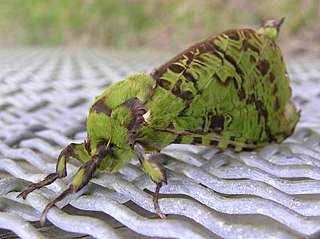
Aenetus is a genus of moths of the family Hepialidae. There are 24 described species found in Indonesia, New Guinea, New Caledonia, Australia and New Zealand. Most species have green or blue forewings and reddish hindwings, but some are predominantly brown or white. The larvae feed in the trunks of living trees, burrowing horizontally into the trunk, then vertically down.
The greater Brisbane area of Queensland Australia, has many species of indigenous flora. This article links the flora to its geography with:

The Pine River is a small river in South East Queensland, Australia.

The Jardin botanique de la Villa Thuret is a renowned botanical garden located on the grounds of the Villa Thuret, 90, chemin Raymond, Antibes Juan-les-Pins, Alpes-Maritimes, Provence-Alpes-Côte d'Azur, France. It is open weekdays without charge.

Epicoma melanospila, the black spot moth, is a moth of the family Notodontidae. It was first described by Wallengren in 1860 and it is found in Australia.

Epidesmia chilonaria is a species of moth of the family Geometridae. It is found in the south-eastern quarter of Australia.

Cleora is a genus of moths in the family Geometridae. The genus was erected by John Curtis in 1825.
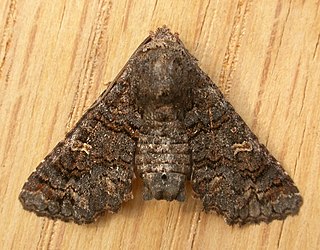
Pataeta carbo is a moth in the family Euteliidae first described by Achille Guenée in 1852.

Phrissogonus is a monotypic moth genus in the family Geometridae erected by Arthur Gardiner Butler in 1882. Its only species, Phrissogonus laticostata, the apple looper, was first described by Francis Walker in 1862. It is found in Australia, New Caledonia and New Zealand.
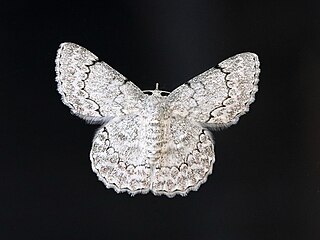
Pingasa chlora, the white looper moth or flower-eating caterpillar, is a species of moth of the family Geometridae first described by Caspar Stoll in 1782. It is found Sundaland, the Philippines, Sulawesi and from the Moluccas to Queensland, Australia.

Cleora cinctaria, the ringed carpet, is a moth of the family Geometridae. The species was first described by Michael Denis and Ignaz Schiffermüller in 1775. It is found from Europe to southern Siberia, Turkey, the Caucasus, central Asia and Mongolia. It is also found in Japan.
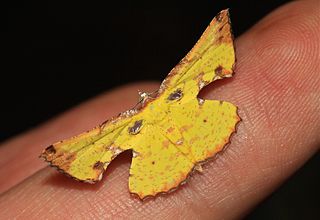
Corymica pryeri is a species of moth of the family Geometridae first described by Arthur Gardiner Butler in 1878. It is found in Japan, Taiwan, the north-eastern Himalayas, Sumatra, Borneo, New Guinea and possibly Queensland, Australia.

Aenetus ligniveren, the common splendid ghost moth, is a moth in the family Hepialidae. It is found from southern Queensland to Tasmania.

Eucalyptus brownii, commonly known as the Brown's box or Reid River box, is a species endemic to Queensland. It is a small to medium-sized tree with hard, tough, fissured bark, lance-shaped adult leaves, flower buds in groups of eleven to fifteen, white flowers and usually cup-shaped fruit.
Strepsicrates rhothia is a species of moth of the family Tortricidae first described by Edward Meyrick in 1910. It is found in Taiwan, Sri Lanka, India, the Democratic Republic of the Congo, Ghana, Madagascar, Mauritius and South Africa.
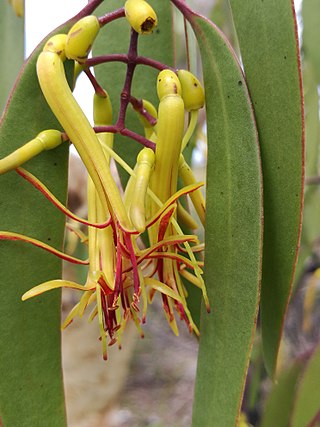
Muellerina eucalyptoides, commonly known as creeping mistletoe, is a hemiparasitic aerial shrub in the family Loranthaceae. The species is endemic to Australia.

Hypomeces pulviger, also known as the gold-dust weevil or green weevil, is a species of beetle in the true weevil family. The adult weevil can reach a length of about 14 mm (0.6 in) and is covered with iridescent green or yellowish-green dust-like scales all over the body. This species can be found in India, tropical Southeast Asia, and the Philippines. Both the larvae and adults are crop pests. The larvae live in and pupate in the soil, feeding on living plant roots. The adult weevils are long-lived, doing damage to foliage, and sometimes defoliating young bushes and nursery trees.

Flindersia dissosperma, commonly known as scrub leopardwood, is a species of small tree in the family Rutaceae and is endemic to eastern-central Queensland. It usually has pinnate leaves with between three and five elliptical to egg-shaped leaves, panicles of white to cream-coloured flowers and fruit studded with rough points.


















